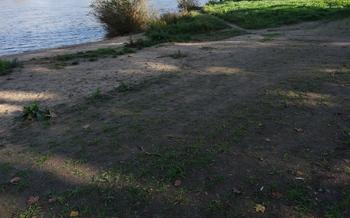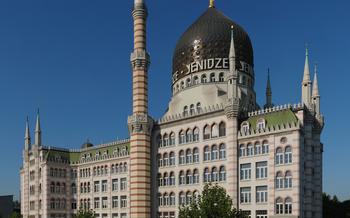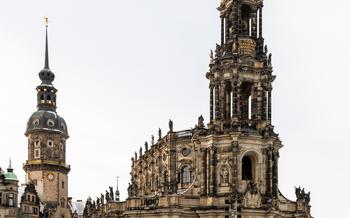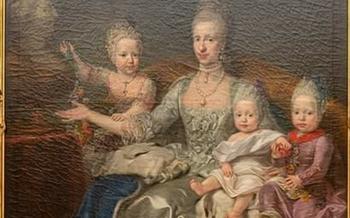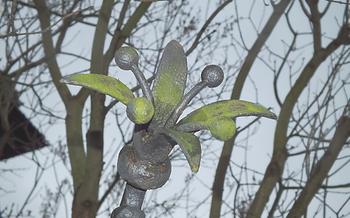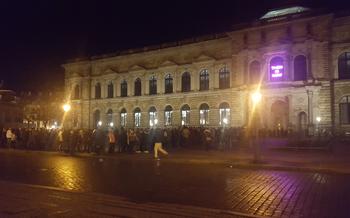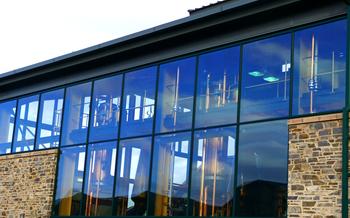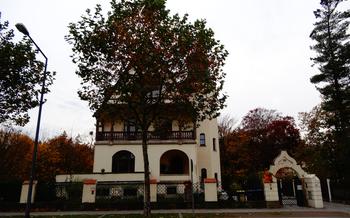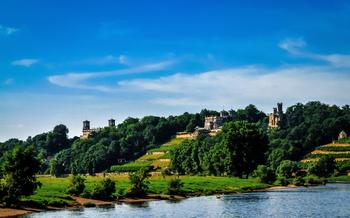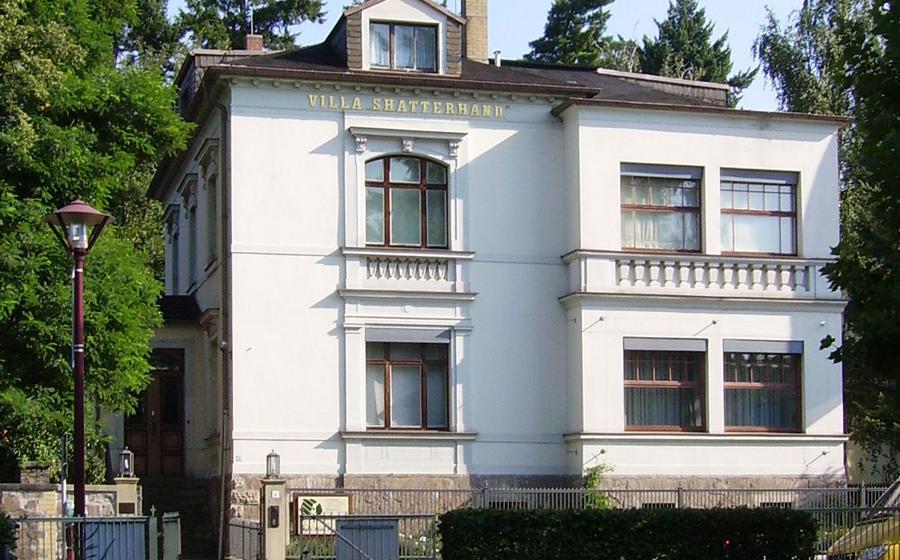
Villa Shatterhand and the Karl May Museum
- Villa Shatterhand: A Journey into the World of Karl May
- Karl May Museum: Exploring the Life and Works of a Literary Legend
- The Man Behind the Legend: Karl May's Fascinating Life
- Early Years and Influences
- Extensive Travels and Adventures
- Controversies and Criticism
- Legacy and Lasting Impact
- Literary Masterpieces: Exploring Karl May's Famous Works
- Villa Shatterhand's Architecture: A Blend of Styles
- Unique Features and Design Elements
- Inspiration from Different Architectural Styles
- Symbolism and Hidden Meanings in the Architecture
- Current Restoration Efforts to Preserve the Villa's Heritage
- Interactive Experiences at the Karl May Museum
- Themed Events and Exhibitions: A Dynamic Museum Experience
- Radebeul's Natural Beauty: Exploring the Surroundings
- Villa Shatterhand's Current Use: A Cultural Center
- Insider Tip: Plan Your Visit
Villa Shatterhand: A Journey into the World of Karl May
In the heart of Radebeul, a charming town nestled in the picturesque Elbe Valley, lies a remarkable architectural gem: Villa Shatterhand. This magnificent villa, built in 1895, holds a profound connection to the legendary German author Karl May, known for his captivating adventure novels set in the Wild West and the Orient. Originally commissioned by May's publisher, Friedrich Ernst Fehsenfeld, the villa served as the author's residence and creative sanctuary for over two decades.
May, captivated by the allure of the American frontier and the exoticism of the Orient, found inspiration within the villa's walls. Here, he penned some of his most iconic works, including the adventures of Old Shatterhand and Winnetou, tales that continue to enthrall readers worldwide.
The villa's architecture, a blend of Moorish and Art Nouveau styles, reflects May's eclectic tastes and fascination with different cultures. Its unique design elements, such as the intricate tilework, horseshoe arches, and vibrant colors, contribute to its distinctive character.
Today, Villa Shatterhand stands as a testament to May's literary legacy. Lovingly restored and preserved, the villa serves as a museum dedicated to the author's life and work. Visitors can embark on a journey through May's literary world, exploring the origins of his beloved characters and delving into the fascinating stories that captivated generations of readers.
Karl May Museum: Exploring the Life and Works of a Literary Legend
The Karl May Museum, located in the heart of Radebeul, is a must-visit destination for anyone interested in the life and works of this legendary author. Through a captivating blend of exhibits, interactive displays, and multimedia experiences, the museum offers a comprehensive journey into the world of Karl May.
Visitors can delve into the fascinating life of Karl May, from his humble beginnings in Saxony to his extensive travels across the globe. Interactive exhibits showcase his adventurous spirit and the diverse cultures that influenced his writing. Through personal artifacts, manuscripts, and photographs, the museum provides an intimate glimpse into the mind of this prolific author.
The museum also explores the literary legacy of Karl May. His most famous works, including the adventures of Old Shatterhand and Winnetou, are brought to life through immersive storytelling and multimedia displays. Visitors can experience the thrill of these epic tales and gain insights into the themes of friendship, courage, and cultural understanding that permeate May's writings.
Temporary exhibitions and special events at the Karl May Museum add to the dynamic and engaging experience. These exhibitions often focus on specific aspects of May's life or work, offering visitors a deeper dive into his multifaceted persona. The museum also hosts lectures, workshops, and other events that bring together experts, enthusiasts, and fellow travelers to celebrate the enduring legacy of Karl May.
The Man Behind the Legend: Karl May's Fascinating Life
Early Years and Influences
Karl May was born on February 25, 1842, in Hohenstein-Ernstthal, a small town in Saxony, Germany. His father, a weaver, and his mother, a lace-maker, instilled in him a love of storytelling and adventure from an early age. Karl's vivid imagination was further fueled by his extensive reading of travelogues, adventure novels, and tales from around the world.
Extensive Travels and Adventures
Driven by an insatiable thirst for adventure, Karl May embarked on numerous journeys throughout his life. He traveled across the Middle East, North Africa, and the Americas, immersing himself in different cultures and collecting stories from the people he met. These experiences provided him with a wealth of material for his future writings.
Controversies and Criticism
Karl May's work has been the subject of both praise and criticism. While his adventure novels captivated readers worldwide, he was accused of plagiarism and fabricating his travel experiences. Despite these controversies, May's work continues to be enjoyed by millions of readers who appreciate his ability to transport them to faraway lands and introduce them to diverse cultures.
Legacy and Lasting Impact
Karl May's legacy is complex and multifaceted. He is celebrated as one of the most successful and influential German authors of all time, having sold over 200 million copies of his books worldwide. His work has been translated into over 30 languages and adapted into numerous films, television series, and other media. May's stories continue to inspire and entertain generations of readers, leaving an indelible mark on popular culture.
Literary Masterpieces: Exploring Karl May's Famous Works
Karl May's literary creations have captivated generations of readers worldwide, transporting them to exotic lands and introducing them to unforgettable characters. His most famous works include the epic Winnetou trilogy, set in the Wild West and chronicling the adventures of the Apache chief Winnetou and his friendship with the German immigrant Old Shatterhand. These novels explore themes of friendship, loyalty, and the clash between different cultures.
Another notable series is the Orient Cycle, which takes readers on a thrilling journey through the Middle East, featuring the adventures of the resourceful traveler Kara Ben Nemsi. Through these tales, May explores themes of cultural understanding, religious tolerance, and the search for hidden treasures.
May's work is characterized by its vivid descriptions, fast-paced action, and larger-than-life characters. His stories often convey messages of peace, respect for diversity, and the importance of standing up for justice. His ability to blend adventure, history, and cultural insights has made his books timeless classics enjoyed by readers of all ages.
Villa Shatterhand's Architecture: A Blend of Styles
Unique Features and Design Elements
Villa Shatterhand, the former residence of Karl May, stands out for its eclectic architectural style, blending elements of various traditions. The villa's most striking feature is its asymmetrical design, with different sections and wings jutting out in various directions. This unconventional layout reflects May's desire to create a unique and personalized living space.
The villa's exterior showcases a mix of architectural styles, including Moorish, Gothic, and Art Nouveau influences. Intricate carvings, colorful tiles, and decorative elements adorn the facade, creating a visually captivating spectacle. The use of different materials, such as sandstone, wood, and plaster, adds depth and texture to the building's exterior.
Inspiration from Different Architectural Styles
May's travels and fascination with diverse cultures greatly influenced the architectural design of Villa Shatterhand. The Moorish-style arches and intricate tilework evoke the exotic atmosphere of the Middle East, which May experienced during his extensive travels. The Gothic elements, with their pointed roofs and stained glass windows, reflect his appreciation for medieval European architecture.
The Art Nouveau influences are evident in the villa's fluid lines, organic motifs, and asymmetrical layout. This style, popular during the late 19th and early 20th centuries, emphasized individuality and artistic expression, perfectly aligning with May's creative spirit.
Symbolism and Hidden Meanings in the Architecture
Beyond its aesthetic appeal, Villa Shatterhand's architecture is infused with symbolism and hidden meanings that reflect May's beliefs and aspirations. The villa's layout, with its central tower and radiating wings, is said to represent a microcosm of the universe, with May's writing room positioned at the heart of it all.
Various decorative elements throughout the villa hold symbolic significance. The use of eagles and falcons in the carvings represents strength and courage, qualities that May admired and embodied in his literary heroes. The depiction of dragons and mythical creatures symbolizes the battle between good and evil, a theme prevalent in May's works.
Current Restoration Efforts to Preserve the Villa's Heritage
In recent years, Villa Shatterhand has undergone extensive restoration and preservation efforts to maintain its historical integrity and architectural beauty. The restoration process involves repairing damaged elements, restoring original paint colors, and preserving the intricate decorative details that make the villa so unique.
These efforts aim to preserve Karl May's legacy and ensure that future generations can appreciate the architectural masterpiece that is Villa Shatterhand, a testament to his boundless imagination and love for diverse cultures.
Interactive Experiences at the Karl May Museum
The Karl May Museum offers a range of interactive exhibits and immersive experiences that bring the author's world to life. Visitors can engage with multimedia displays, virtual reality experiences, and hands-on activities that provide a deeper understanding of Karl May's life and work.
Using state-of-the-art technology, the museum offers virtual reality experiences that transport visitors to the exotic lands that inspired Karl May's stories. These immersive experiences allow visitors to explore the untamed wilderness of the American West, the vibrant cultures of the Orient, and the ancient mysteries of the Middle East.
Interactive displays throughout the museum invite visitors to engage with Karl May's characters, themes, and historical context. Touch screens, interactive maps, and multimedia presentations provide in-depth information and insights into the author's creative process and the impact of his work on popular culture.
The Karl May Museum also offers a variety of hands-on activities for visitors of all ages. Children can participate in storytelling workshops, craft activities, and scavenger hunts that encourage them to explore the museum's exhibits and learn about Karl May's adventures.
Through its interactive experiences, the Karl May Museum provides a dynamic and engaging learning environment that allows visitors to immerse themselves in the world of one of Germany's most beloved authors.
Themed Events and Exhibitions: A Dynamic Museum Experience
The Karl May Museum is not just a static repository of artifacts and information; it is a dynamic and engaging space that regularly hosts themed exhibitions and events to keep visitors enthralled. These exhibitions delve into specific aspects of Karl May's life, work, and legacy, offering fresh perspectives and insights.
Temporary exhibitions showcase rare and unseen items from the museum's collection, shedding light on lesser-known facets of May's life and travels. Special events, workshops, and lectures provide opportunities for visitors to engage with experts, fellow enthusiasts, and even descendants of Karl May himself.
One of the highlights of the museum's events calendar is the annual Karl May Festival, which takes place every summer. This festival brings Radebeul to life with a vibrant celebration of Karl May's work and its enduring impact on popular culture. Visitors can immerse themselves in the world of Winnetou and Old Shatterhand through live performances, reenactments, and interactive activities.
The Karl May Museum's commitment to providing a dynamic and engaging experience ensures that visitors of all ages and interests can discover something new and captivating with each visit. Whether you're a long-time fan of Karl May's work or simply curious to learn more about this fascinating figure, the museum's themed events and exhibitions offer a rich and rewarding experience.
Radebeul's Natural Beauty: Exploring the Surroundings
Beyond its rich literary heritage, Radebeul boasts stunning natural beauty that invites exploration. Surrounded by picturesque vineyards, lush forests, and meandering rivers, the town offers a haven for nature enthusiasts and outdoor adventurers.
Radebeul's idyllic setting is perfect for hiking and biking excursions. Well-marked trails wind through the scenic countryside, leading to breathtaking viewpoints and hidden gems. Cyclists can pedal along the scenic Elbe River, enjoying panoramic views of the valley and the passing vineyards.
For a unique perspective, take a leisurely boat trip on the Elbe, admiring the picturesque landscapes from the water. Alternatively, immerse yourself in the tranquil atmosphere of the town's parks and gardens, offering serene spaces for relaxation and contemplation.
Radebeul's natural beauty is celebrated through various local traditions and festivals. The annual wine festival, for example, showcases the region's viticulture heritage, with tastings, music, and traditional festivities. Other events highlight the town's agricultural traditions, such as the harvest festival, where locals gather to celebrate the bounty of the land.
Villa Shatterhand's Current Use: A Cultural Center
Villa Shatterhand, a testament to Karl May's literary genius, stands today as a vibrant cultural center, inviting visitors to delve into the world of adventure and imagination. Following its restoration, the villa has been transformed into a dynamic space that celebrates May's legacy and promotes cultural exchange.
Exhibitions, events, and workshops related to Karl May and his work are regularly held within the villa's walls. Visitors can immerse themselves in the author's life and writings through interactive displays, captivating storytelling, and thought-provoking discussions.
Collaboration with other cultural institutions in the region ensures a diverse range of programming, showcasing the rich tapestry of Radebeul's cultural heritage. The villa serves as a platform for local artists, writers, and performers to share their work with the community.
Plans for future development and expansion are underway, aiming to further enhance the villa's role as a cultural hub. With its unique blend of history, literature, and innovation, Villa Shatterhand continues to inspire and captivate audiences, ensuring that Karl May's legacy lives on for generations to come.
Insider Tip: Plan Your Visit
Best Time to Visit:
The best time to visit the Villa Shatterhand and Karl May Museum is during the warmer months from April to October when the weather is pleasant for exploring the outdoor areas of the villa and the surrounding historic neighborhood of Radebeul.
Getting to Radebeul:
Radebeul is easily accessible by public transportation. Take the S-Bahn (commuter train) line S1 from Dresden Central Station (Hauptbahnhof) and get off at Radebeul Ost station. From there, it's a short walk to the Villa Shatterhand and the Karl May Museum. You can also take a regional train from Dresden to Radebeul Ost station.
Combining Attractions:
Combine your visit to the Villa Shatterhand and Karl May Museum with other attractions in the area. The Radebeul Wine Museum offers insights into the region's viticulture and winemaking traditions. The Karl May Festival, held annually in June, brings the characters and stories of Karl May to life with live performances and reenactments.
Local Cuisine:
Radebeul is known for its culinary specialties, influenced by Saxon and Bohemian traditions. Try local dishes like "Sauerbraten" (marinated roast beef), "Knödel" (dumplings), and "Dresdner Christstollen" (fruitcake). For a sweet treat, indulge in the famous "Eierschecke," a layered cake with quark, raisins, and almonds.
Practical Information:
- Allow at least 2-3 hours to explore the Villa Shatterhand and the Karl May Museum.
- Guided tours are available in German and English.
- Check the museum's website for current opening hours, admission fees, and special events.
- Combine your visit with a stroll through the historic center of Radebeul, admiring the beautiful architecture and visiting other cultural attractions.
